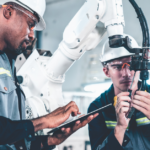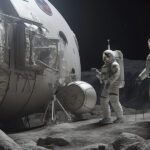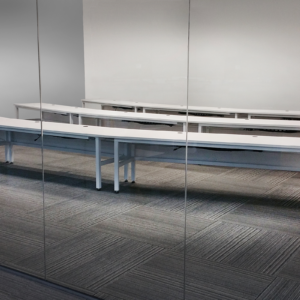Elon Musk’s long-term vision to create a colony on Mars is re-booting our collective dream of space exploration for a new generation. Will SpaceX replace NASA – or will it influence NASA to do science in space at an unprecedented scale?

Given how successful SpaceX has become, it’s hard to remember that not that long ago it was an idea conjured up by a young Silicon Valley startup returning home from an unsuccessful Russian business trip. On this fateful venture, Elon Musk had tried to buy some Russian space rockets to fulfill his dream of creating a human colony on the red planet Mars.
Rebuffed, Musk reportedly built a financial spreadsheet during the flight home — and determined it was financially feasible to build the space rockets themselves. The SpaceX concept was born.
How hard could it be?
As the next six immensely difficult years went by — it became apparent that Musk’s dream was almost not to be…
The scene:
In those early days, SpaceX was an unwelcome startup in the ‘big boys’ aerospace club. When Vandenberg Air Force Base (just a short commute up the Pacific Coast from SpaceX’s Los Angeles headquarters) waved them off, Musk scrambled to find a new launch site — ideally somewhere along the Earth’s equator.
Fast forward in time to a scene that can only be described (in a tongue-in-cheek manner) as reminiscent of a James Bond spy thriller.
Specifically, we’re thinking of the blockbuster 1967 Bond film You Only Live Twice, whose fictional SPECTRE company shares these plot elements with SpaceX:
Rocket Ship Factory:
A team of eager Hollywood extras works overtime to build a rocket ship – this time played by real SpaceX rocket scientists from Los Angeles.
Remote Island Location:
Instead of working inside a Japanese island volcano, SpaceX operates out of Kwajalein Island (or Kwaj for short), a remote South Pacific Island between Guam and Hawaii
Mastermind at Work
Instead of the evil genius Blofeld, we have a mad genius — played by none other than Elon Musk — who dreams of creating a human colony on Mars.
The unauthorized biography “Elon Musk: Tesla, SpaceX, and the Quest for a Fantastic Future” captures the sheer determination to succeed in the face of nearly insurmountable odds.
Three times the SpaceX team launched their test rockets into space from Kwaj, and three times they met with tragic failure.
The first attempt on March 24, 2006, to launch a Falcon 1 rocket into Earth’s orbit was nearly fatal for the personnel on the ground. When the rocket failed to launch properly, it returned to Earth under power, crashing into the launch pad and partially destroying the machine shop. An aluminum nut corroded by the marine air was the apparent culprit.
Musk’s post mortem was to the point: “SpaceX is in this for the long haul and, come hell or high water, we are going to make this work.”
The second attempt on March 15, 2007, went seemingly fine for the first four or five minutes — until fuel sloshed around in a tank, creating a momentary gap in fuel supply which in turn led to a ‘flame out.’
The third attempt on August 2, 2008, was just as heartbreaking: the Falcon 1 launch was seemingly flawless, until, during separation, the first stage didn’t fall cleanly away as intended, but instead, accelerated just enough to bump into the second stage rocket, fatally damaging it.
Everything was on the line now.
Within the rocket community, the Falcon I program was now in serious doubt. Questions arose. For example, thanks to the separation mishap, no one knew if the fuel sloshing issue that caused the earlier failed launch was corrected in the third attempt or not.
But an even more worrisome question was burning through — financial burn through. SpaceX was spending vast amounts of cash each month to keep the operation going. Musk had used his financial windfall from eBay buying PayPal to fund SpaceX, but now those funds were dwindling at a rapid rate.
Without a successful Falcon I launch, there were no signed contracts to pay for the aggressive development schedule set down by Musk. For Musk had his rocket engineers not only working on Falcon I, but also two other more advanced rockets which could help them land lucrative government contracts. These were the workhorse Falcon 5 (designed to ferry supplies to the International Space Station or lift heavy payloads like satellites into geosynchronous orbit) and the even larger Falcon 9, which could transport human passengers in its Dragon space capsule, potentially replacing the retired Space Shuttle.
But the money that Falcon 5 and Falcon 9 contracts would bring to the company’s dwindling coffers was out of reach until a successful Falcon 1 launch. Preparations for the fourth launch attempt were going at breakneck speed. To save time, the rocket body built in LA was sealed up in plastic wrap and flown aboard a jet plane to Kwaj — only to buckle like a water bottle in response to air pressure changes in flight. Two weeks were lost working 24X7 to repair the damage.
Finally, on Sept 28, 2008, with the future of the company on the line, the SpaceX Kestrel motor fired up and Falcon I lifted off. The Kestrel ran for six minutes, as planned. The second stage kicked in, and, at around nine minutes, Earth orbit was achieved — the first-ever accomplishment by a private company.
In Elon Musk’s words: “The fourth time’s the charm.”
It took SpaceX six years to reach this milestone. Yet, the financial pressure facing the company even after the successful launch was greater than ever before. Pundits latched onto the cash flow woes of both SpaceX and Elon Musk’s other company, Tesla Motors. Under intense pressure, Musk pulled together another $40 million financing round, which closed on Christmas Eve 2008. The last-minute deal saved Tesla from certain financial ruin. Then, unexpectedly, Musk was rewarded with an early Christmas gift from NASA, which tapped SpaceX with a $1.6 billion payment for a dozen transport trips to the International Space Station.
Five Management Principles We Can Learn from Elon Musk
Elon Musk knows exactly what he wants. How? He has a clear, singular vision for each of his businesses.
Musk’s vision for SpaceX:
Make humans a multi-planetary species (by colonizing Mars). This will help ensure our long-term survival chances.
Musk’s vision for Tesla Motors (and by extension SolarCity*)
(* Musk has just announced SolarCity will merge with Tesla Motors)
Eliminate use of fossil fuels by using energy from the sun.
With a clear vision statement for each of his initiatives, Musk is able to make important decisions quickly.
But what can we learn about his management principles?

We’ve observed at least five management principles practiced by Elon Musk:
1. Instead of Outsourcing Manufacturing, Do It Yourself
As American manufacturers of furniture, this principle is near and dear to our hearts:
Both SpaceX and Tesla Motors manufacture their key product components in-house — in the USA — at prices up to 10 times cheaper than it would cost to purchase comparable certified aerospace or automotive components. This reverses the trend of leading companies like Apple or Boeing (particularly in the case of the original Boeing 787) that outsourced much of their manufacturing.
What about some examples?
Here are some great ones: SpaceX has mastered how to use 3D printers to create rocket motors out of temperature resistant Inconel alloy; they have become world experts in friction stir welding which mean they can fabricate large-scale rocket bodies together out of thin metal alloy shells without resorting to flexible joints (which doomed the Challenger launch); they have developed sophisticated rocket avionics systems for as little as $10,000. Next on the ‘Do It Yourself’ agenda is a new initiative: building the actual satellite payloads in-house.
Tesla Motors takes a similar approach: they research, develop, and manufacture their own batteries, complex carbon-fiber car body components, and several other items in-house.
(Of course, we don’t want SpaceX or Tesla Motors to build everything — certainly not all their furniture — as we are not only a big fan of SpaceX, but we’ve also supplied SpaceX with technical furniture for their facilities.)
2. Devise a Master Plan to Go Faster, Recycle, Reuse and Automate
Developing a master plan that is revealed over time seems to be a favored approach of Elon Musk. He seems to revel in the moment when the public and the pundits discover what he’s been planning all along.
For example, Tesla Motors customers, much to their delight, discovered that Tesla can deploy entirely new features in their cars remotely (such as self-driving assist modes, increased performance, longer battery life) without having to upgrade their hardware (e.g. vehicles). In fact, there are no model years for Tesla cars; the improvements are launched as they are ready.
By design, Tesla Models S, X and the new upcoming Model 3 also share an extraordinarily high number of internal parts — by design — including a battery pack that can be removed and replaced by a robot mechanic. Similarly, at SpaceX, the rocket motor designs are shared between Falcon 1, Falcon 5, and Falcon 9, along with many other components.
Recycling is another key element in Musk’s planning approach: SpaceX was the first to land a rocket motor back on dry land, with the intention of recycling it. SpaceX later successfully landed a rocket motor over water onto an automated, robot barge.
3. Everyone in the Organization Needs to Help Drive down Costs
Recycling brings us to the next principle: driving down costs.
Elon Musk has taken important elements of the Silicon Valley startup culture, such as maintaining a keen awareness of ‘the burn rate’ (e.g. how much money is being spent per month, particularly before a return on the investment is realized) and has injected this entrepreneurial way of thinking into the aerospace and automotive industries.
Years of ‘cost plus’ projects in military and government contracts have led project planners to be somewhat disconnected from actual costs and spending rates. Not under Elon Musk’s watch.
An example directive: a Falcon 9 launch, which now costs between $60 and $90 million needs to drop down to $20 million, with higher launch frequencies. Does that sound like a discount trip on Southwest Airlines? It should. Musk has said he wants SpaceX to be the Southwest Airlines of space.
4. Software Can Become the Core Product Offering
Back in South Africa, twelve-year-old Elon Musk published software code for an original design video game, called Blastar. Since that time, software has been on his mind.
Now that Musk has announced intentions to add satellites to his roster of projects, we expect to see even more tightly integrated software solutions in the rocket business eco-sphere. Here’s an example: it’s been reported that SpaceX wants to develop their own in-house computational fluid dynamics (CFD) software as a competitive advantage for building and launching rockets.
In the public eye, Tesla Motor cars and SolarCity solar cell installations are more readily accessible examples of how software with artificial intelligence is becoming the core of the product offering. Just as a Tesla car can communicate with the factory, with its owner, and with the environment — to the point it can assist in driving the car — so can SolarCity installations communicate with homeowners and other SolarCity installations to manage a fluid yet robust electrical grid.
5. Don’t Rely on Silo Experts, Expand Your Sources
Here is a final observation of Elon Musk’s management principles: do not rely on conventional approaches from conventional sources.
As an example, Musk learned from experience to bypass expensive certified aerospace equipment where possible. In many cases, traditional mil-spec certified gear was not only more costly but less sophisticated than comparable consumer-grade electronics (which usually proved to be just as reliable).
Another example: when trying to buy friction stir welded rocket bodies, Musk turned away from traditional aerospace suppliers to seek out new suppliers in an unrelated industry (agriculture tank manufacturers) who were able to weld thin metal structures faster and cheaper than traditional vendors.
The large touch screens in Tesla Model S cars are another example: these were sourced from consumer electronics manufacturers — then customized by Tesla engineers. They beat Apple’s iPad to market by a mile.
Defining a Symbiotic Relationship with NASA
Thanks to Musk’s vision and management principles, SpaceX achieved a significant milestone in June of 2010, when a Falcon 9 lifted a SpaceX Dragon capsule into space. After a technical glitch, it was intercepted by the arm of the International Space Station, with the now famous quote: “… it looks like we’ve got us a dragon by the tail.”
Thanks to regular Falcon 9 launches into space (averaging twice a month), SpaceX is now firmly part of the ‘Big Boys’ space club. This was underscored at a congressional hearing in 2014, where Musk contrasted the cost of single launch by ULA (a.k.a. the United Launch Alliance, a consortium of Boeing and Lockheed-Martin) at $380 million per flight with SpaceX’s price of only $90 million.
Despite the cost advantages of SpaceX (not to mention the security advantages of having its products being made in the USA), NASA continues to hedge its bets. They chose to select two competing suppliers to develop a solution to transport human passengers to the ISS by 2017. The contract broke down like this: NASA awarded SpaceX $2.6 billion and Boeing $4.2 billion.
Musk is sanguine. He was quoted as saying “I don’t mind if Boeing gets twice as much money for meeting the same NASA requirements as SpaceX with worse technology… Having two companies involved is better for the advancement of human spaceflight.”
And that is a perfect example of Musk’s philosophy. As long as a decision helps advance his vision of colonizing Mars, he’s for it.
And so are we.
Contact Us for Your Aerospace Furniture Projects
What do SpaceX, Boeing, NASA, and Lockheed-Martin all have in common? They all trust Formaspace to furnish their aerospace innovation lairs. If you’d like to learn more about how we can help you organize your office, manufacturing or research space, make contact with one of our Formaspace Design Consultants today.









